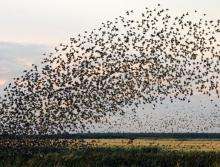July 28, 2014 report
Study of starling flight reveals message from turning bird sweeps through flock at constant speed

A team of researchers with members from several countries working together in Rome, Italy, has come up with a new explanation of how it is that starlings are able to fly in a flock in a way that makes them appear as a single organism. In their paper published in the journal Nature Physics, the team describes how they used high-speed cameras to capture and study flight movement by individual bird members and what they found as a result.
Starling flight is as mesmerizing as it is mystifying—flocks of hundreds or thousands of birds sweep across the sky as if a single organism. The birds flying over Rome in particular have captured the imagination of bird enthusiasts, tourists, film makers and scientists alike. How do individual birds know when to turn and which way? Some have suggested it's a random thing, each bird simply flies making sure not to run into a neighbor. Others have suggested that some birds initiate a turn and others follow, creating a diffusion effect. In this new study, the researchers suggest that none of the earlier theories is correct—they've come up with something brand new.
To get a better look at the birds in flight, the researchers recorded flocks flying over Rome with high speed cameras and then took the results into their lab for examination. They found that turns are almost always initiated by just a few birds, but rather than other birds trying to figure out where to turn too, they instead simply copy how sharply their neighbor turns. This allows for the turn message to propagate through the flock at a very fast constant speed—approximately 20 to 40 meters per second, the team calculated. That constant message transfer speed means that each bird in a flock can respond in as little as half a second, without causing the flock to break apart.
Perhaps even more interesting is that when the researchers applied a spin factor for the turns by the birds, they found that applying it to the flock as a whole allowed for use of the same mathematical equations as physicists use to describe superfluid helium. The researchers believe that's not a coincidence, as there are many examples of physics and math principles that apply to the natural world.
More information: Nature Physics, DOI: 10.1038/NPHYS3035
Journal information: Nature Physics
© 2014 Phys.org



















